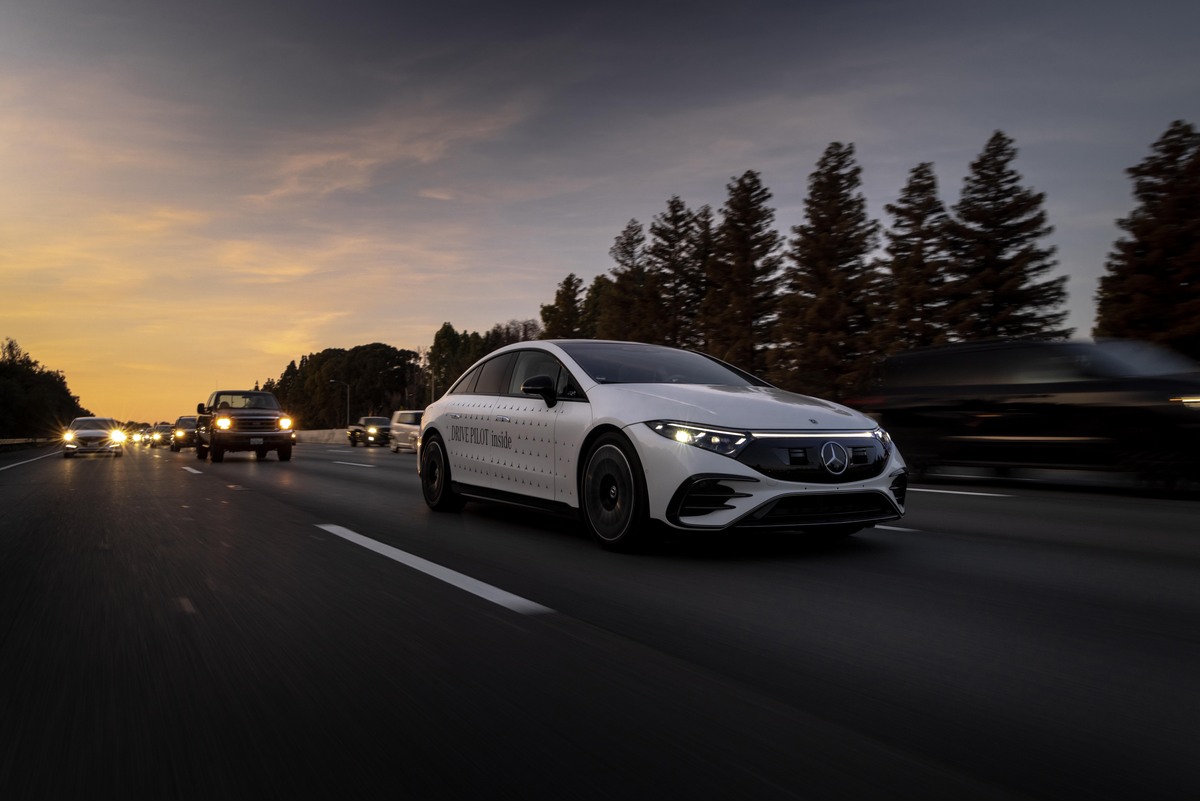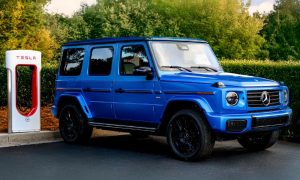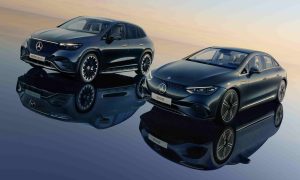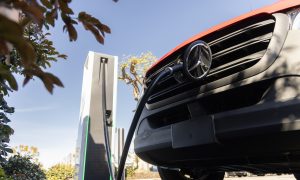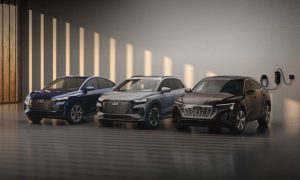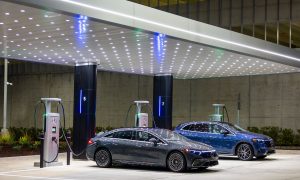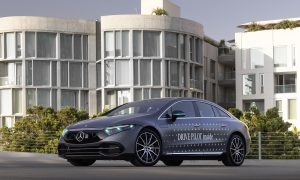Mercedes-Benz has seen the sale of its electric vehicles (EVs) increase significantly in the U.S. this year. However, a new report shows that dealers have had difficulty keeping up with inventory levels for the automaker’s EQ lineup, with sales times for the EVs exceeding the luxury segment average.
In the third quarter, Mercedes sold 10,423 EVs in the U.S., marking a 284-percent increase year over year. Despite the gradual increase in EV sales, the German automaker’s EVs are sitting on dealership lots and are not being sold off as quickly as other vehicles.
According to a report from Automotive News citing Edmunds data, Mercedes-Benz battery-electric EQ models took an average of 82 days to sell at dealerships in September. Comparatively, vehicles across the overall luxury segment averaged 57 days, while BMW vehicles took around 38 days to sell.
In various anonymous interviews with Automotive News, Mercedes dealers pointed to the brand’s lack of effort in responding to growing EV competition with sales programs and to the products themselves as the reasons for heightened inventory levels. One person who runs a Mercedes store said he currently has over six months’ worth of EVs and only a 50-day supply of the company’s gas cars.
“The EVs are coming whether or not you asked for them or earned them,” the retail store operator said. “There is too much of a price premium — especially at the top end of the EQ lineup — and almost no [lease] support.”
He added that the EQ models didn’t have the same “lust factor” as some of the automaker’s classic gas cars, including the S-Class sedan and the AMG-GT coupe.
“Our cars need to be ‘want’ cars,” he said. “The S-Class has maintained good loyalty because it’s aspirational. An EQS is not something that most people aspire to own.”
Credit: Automotive News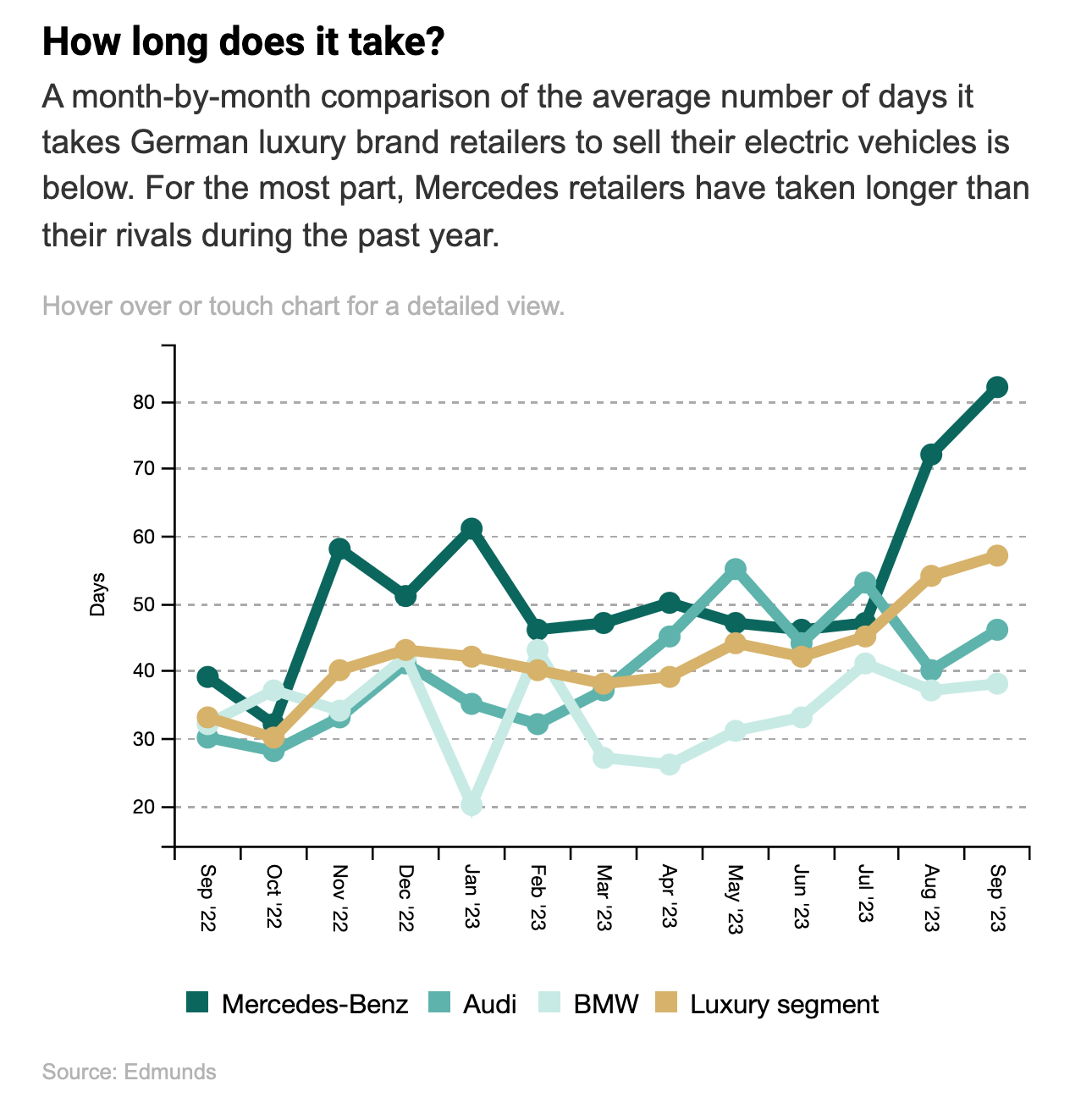
A Mercedes spokesperson declined to comment on internal discussions with its retailers.
CEO of Mercedes-Benz U.S., Dimitris Psillakis, blamed slow sales on a lack of product variety and on the EV segment being so new. Additionally, he pointed to issues in the supply chain as preventing variety at dealerships and keeping some more affordable models, such as the EQB compact EV, off of their lots.
“We are with a new lineup in a new world,” Psillakis said. “There is no past, there is no experience. We still face challenges around our product lines and have some restrictions coming from suppliers. We don’t always get the volume we want when we want it.”
Psillakis also said that Mercedes didn’t have any supply of the affordable EQB at the beginning of the year. Although this has changed, he says that it still takes time for the EV to reach dealers.
The Mercedes-Benz EV lineup and pricing structure is as follows, according to the automaker’s website:
- EQB (SUV); starts at $52,750
- EQE (sedan); starts at $74,900
- EQE (SUV); starts at $77,900
- EQS (sedan); starts at $104,400
- EQS (SUV); starts at $104,400
Other automakers have also faced difficulty in moving EVs alongside inflation and rising interest rates, and especially in the luxury segment.
The average EV overall sold in 36 days near the beginning of this year, according to a Cloud Theory report cited by Automotive News. By September, the report showed that this number had jumped to 80 days.
The problem is even worse for Mercedes and in the luxury segment overall. The average luxury EV sales time across brands increased by 73 percent in September compared to the same month last year, according to the aforementioned Edmunds data. For Mercedes dealers, the rate increased by 110 percent year over year.
“The ship of early adopters — willing to put a reservation down on virtually any EV announced — has sailed,” says Edmunds Insights Director Ivan Drury.
The report comes after Mercedes delayed its internal goals for electrification earlier this year, now aiming to reach a milestone of half of its auto sales being plug-in hybrids or fully electric by 2026 instead of a year prior. It also comes after Mercedes joined other automakers in adopting Tesla’s charging hardware, dubbed the North American Charging Standard (NACS).
Mercedes-Benz to launch Level 3 automated driving tech in the US by Q4
What are your thoughts? Let me know at zach@teslarati.com, find me on X at @zacharyvisconti, or send your tips to us at tips@teslarati.com.
Elon Musk
Why Tesla’s Q3 could be one of its biggest quarters in history
Tesla could stand to benefit from the removal of the $7,500 EV tax credit at the end of Q3.

Tesla has gotten off to a slow start in 2025, as the first half of the year has not been one to remember from a delivery perspective.
However, Q3 could end up being one of the best the company has had in history, with the United States potentially being a major contributor to what might reverse a slow start to the year.
Earlier today, the United States’ House of Representatives officially passed President Trump’s “Big Beautiful Bill,” after it made its way through the Senate earlier this week. The bill will head to President Trump, as he looks to sign it before his July 4 deadline.
The Bill will effectively bring closure to the $7,500 EV tax credit, which will end on September 30, 2025. This means, over the next three months in the United States, those who are looking to buy an EV will have their last chance to take advantage of the credit. EVs will then be, for most people, $7,500 more expensive, in essence.
The tax credit is available to any single filer who makes under $150,000 per year, $225,000 a year to a head of household, and $300,000 to couples filing jointly.
Ending the tax credit was expected with the Trump administration, as his policies have leaned significantly toward reliance on fossil fuels, ending what he calls an “EV mandate.” He has used this phrase several times in disagreements with Tesla CEO Elon Musk.
Nevertheless, those who have been on the fence about buying a Tesla, or any EV, for that matter, will have some decisions to make in the next three months. While all companies will stand to benefit from this time crunch, Tesla could be the true winner because of its sheer volume.
If things are done correctly, meaning if Tesla can also offer incentives like 0% APR, special pricing on leasing or financing, or other advantages (like free Red, White, and Blue for a short period of time in celebration of Independence Day), it could see some real volume in sales this quarter.
You can now buy a Tesla in Red, White, and Blue for free until July 14 https://t.co/iAwhaRFOH0
— TESLARATI (@Teslarati) July 3, 2025
Tesla is just a shade under 721,000 deliveries for the year, so it’s on pace for roughly 1.4 million for 2025. This would be a decrease from the 1.8 million cars it delivered in each of the last two years. Traditionally, the second half of the year has produced Tesla’s strongest quarters. Its top three quarters in terms of deliveries are Q4 2024 with 495,570 vehicles, Q4 2023 with 484,507 vehicles, and Q3 2024 with 462,890 vehicles.
Elon Musk
Tesla Full Self-Driving testing continues European expansion: here’s where
Tesla has launched Full Self-Driving testing in a fifth European country ahead of its launch.
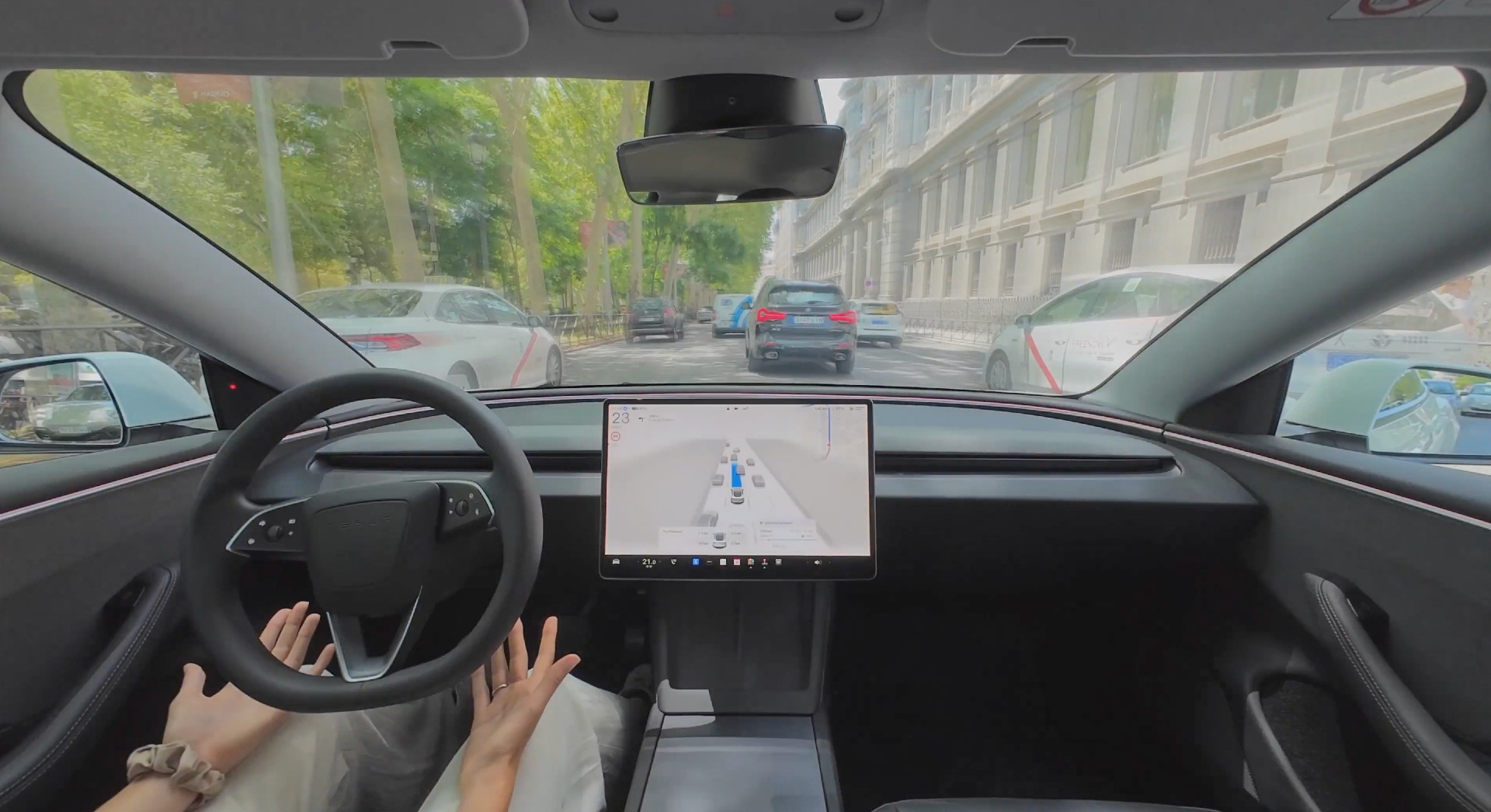
Tesla Full Self-Driving is being tested in several countries across Europe as the company prepares to launch its driver assistance suite on the continent.
The company is still working through the regulatory hurdles with the European Union. They are plentiful and difficult to navigate, but Tesla is still making progress as its testing of FSD continues to expand.
Today, it officially began testing in a new country, as more regions open their doors to Tesla. Many owners and potential customers in Europe are awaiting its launch.
On Thursday, Tesla officially confirmed that Full Self-Driving testing is underway in Spain, as the company shared an extensive video of a trip through the streets of Madrid:
Como pez en el agua …
FSD Supervised testing in Madrid, Spain
Pending regulatory approval pic.twitter.com/txTgoWseuA
— Tesla Europe & Middle East (@teslaeurope) July 3, 2025
The launch of Full Self-Driving testing in Spain marks the fifth country in which Tesla has started assessing the suite’s performance in the European market.
Across the past several months, Tesla has been expanding the scope of countries where Full Self-Driving is being tested. It has already made it to Italy, France, the Netherlands, and Germany previously.
Tesla has already filed applications to have Full Self-Driving (Supervised) launched across the European Union, but CEO Elon Musk has indicated that this particular step has been the delay in the official launch of the suite thus far.
In mid-June, Musk revealed the frustrations Tesla has felt during its efforts to launch its Full Self-Driving (Supervised) suite in Europe, stating that the holdup can be attributed to authorities in various countries, as well as the EU as a whole:
Tesla Full Self-Driving’s European launch frustrations revealed by Elon Musk
“Waiting for Dutch authorities and then the EU to approve. Very frustrating and hurts the safety of people in Europe, as driving with advanced Autopilot on results in four times fewer injuries! Please ask your governing authorities to accelerate making Tesla safer in Europe.”
Waiting for Dutch authorities and then the EU to approve.
Very frustrating and hurts the safety of people in Europe, as driving with advanced Autopilot on results in four times fewer injuries!
Please ask your governing authorities to accelerate making Tesla safer in Europe. https://t.co/QIYCXhhaQp
— Elon Musk (@elonmusk) June 11, 2025
Tesla said last year that it planned to launch Full Self-Driving in Europe in 2025.
Elon Musk
xAI’s Memphis data center receives air permit despite community criticism
xAI welcomed the development in a post on its official xAI Memphis account on X.
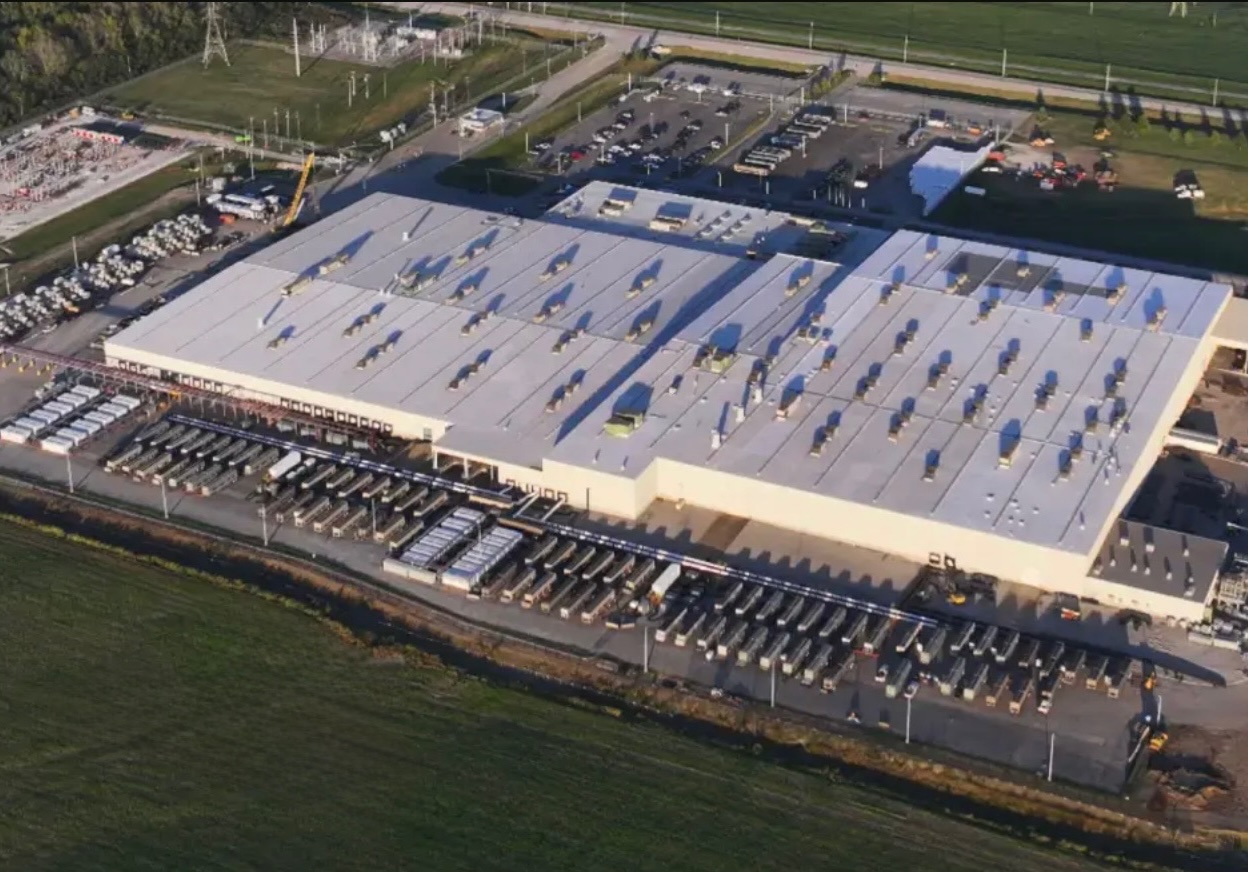
Elon Musk’s artificial intelligence startup xAI has secured an air permit from Memphis health officials for its data center project, despite critics’ opposition and pending legal action. The Shelby County Health Department approved the permit this week, allowing xAI to operate 15 mobile gas turbines at its facility.
Air permit granted
The air permit comes after months of protests from Memphis residents and environmental justice advocates, who alleged that xAI violated the Clean Air Act by operating gas turbines without prior approval, as per a report from WIRED.
The Southern Environmental Law Center (SELC) and the NAACP has claimed that xAI installed dozens of gas turbines at its new data campus without acquiring the mandatory Prevention of Significant Deterioration (PSD) permit required for large-scale emission sources.
Local officials previously stated the turbines were considered “temporary” and thus not subject to stricter permitting. xAI applied for an air permit in January 2025, and in June, Memphis Mayor Paul Young acknowledged that the company was operating 21 turbines. SELC, however, has claimed that aerial footage shows the number may be as high as 35.
Critics are not giving up
Civil rights groups have stated that they intend to move forward with legal action. “xAI’s decision to install and operate dozens of polluting gas turbines without any permits or public oversight is a clear violation of the Clean Air Act,” said Patrick Anderson, senior attorney at SELC.
“Over the last year, these turbines have pumped out pollution that threatens the health of Memphis families. This notice paves the way for a lawsuit that can hold xAI accountable for its unlawful refusal to get permits for its gas turbines,” he added.
Sharon Wilson, a certified optical gas imaging thermographer, also described the emissions cloud in Memphis as notable. “I expected to see the typical power plant type of pollution that I see. What I saw was way worse than what I expected,” she said.
-

 Elon Musk3 days ago
Elon Musk3 days agoTesla investors will be shocked by Jim Cramer’s latest assessment
-

 News1 week ago
News1 week agoTesla Robotaxi’s biggest challenge seems to be this one thing
-

 News2 weeks ago
News2 weeks agoTexas lawmakers urge Tesla to delay Austin robotaxi launch to September
-

 Elon Musk2 weeks ago
Elon Musk2 weeks agoFirst Look at Tesla’s Robotaxi App: features, design, and more
-

 Elon Musk2 weeks ago
Elon Musk2 weeks agoxAI’s Grok 3 partners with Oracle Cloud for corporate AI innovation
-

 News2 weeks ago
News2 weeks agoSpaceX and Elon Musk share insights on Starship Ship 36’s RUD
-

 News2 weeks ago
News2 weeks agoWatch Tesla’s first driverless public Robotaxi rides in Texas
-

 News2 weeks ago
News2 weeks agoTesla has started rolling out initial round of Robotaxi invites

